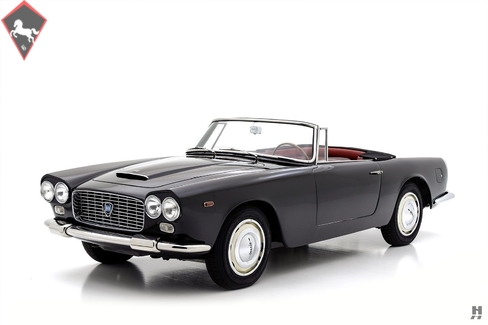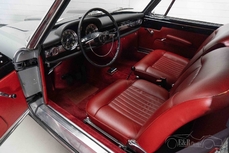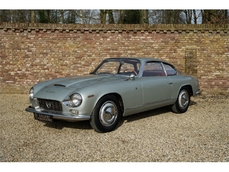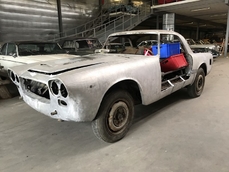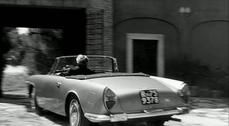Lancia Flaminia 2.8 3C Touring Convertible 1963
Allgemeine Beschreibung :
Vincenzo Lancia began his remarkable career working as a bookkeeper for a bicycle company in Torino, Italy. There, Lancia developed his natural engineering talent by designing and constructing his own bikes. Soon, Lancia would move into the world of automobiles when he took a job at FIAT. At age 19, young Vincenzo was FIAT’s chief inspector and test driver and was soon put to work driving the factory racing cars, where he enjoyed considerable success. However, when a severe crash ended his sporting aspirations, he fell back on his engineering ability, and in 1906 he founded Lancia & C. Fabbrica Automobili.
From the first 1907 Tipo 51 to the Flaminia and Fulvia of the early 70’s, Lancia would develop a reputation for exquisitely engineered automobiles that pushed the boundaries of technology; often with little regard to cost or complexity. It was Lancia that pioneered the use of independent suspension, narrow V-angle engines, the V6, transaxle gearboxes and even the first application of radial tires on a production car. Lancias were built to a standard that enthusiasts compare to that of an “Italian Mercedes-Benz.” Vincenzo Lancia was quite daring when it came to his technical solutions, but many of his early factory-bodied cars came across as somewhat conservative in nature. With style low on Vincenzo’s priority list, dealers and customers took it upon themselves to clothe his brilliant chassis in the finest coachwork Italy had to offer. Thus started a tradition of the great Italian Carrozzerie applying their talents to Lancia platforms to create some of the most memorable sports and GT cars of all time.
In 1957, Lancia announced the replacement for the flagship Aurelia which had been in production since 1950. The new Flaminia continued the theme of technical sophistication and exquisite build quality set by the Aurelia, now with new levels of style and refinement to see it through the 1960s. The Flaminia was powered by an aluminum, 2.5-liter V6 (later increased to 2.8L) and equipped with independent suspension, four-wheel disc brakes mounted inboard at the rear, and a transaxle gearbox for balanced handling. Lancia offered the Flaminia in numerous configurations, including the luxurious Berlina and Coupe by Pininfarina, racy Zagato-built Sport, and a sharp coupe and cabriolet pairing by Carrozzeria Touring of Milan. Sadly, the Flaminia would be one of the last “proper” Lancias as Fiat’s takeover in 1969 would spell the end for the company’s tradition of quality and technical superiority.
For a driver seeking a refined and rapid open GT car in the early 1960s, one would be hard pressed to make a better choice than the Lancia Flaminia GT. This handsome example is one of approximately 180 built in highly desirable specification including the 2.8 liter V6, triple carburetors, and crisp, beautiful Superleggera open coachwork by Carrozzeria Touring. It is a lovely car that is ideally suited to the task of effortless touring in events and rallies.
This car’s Touring coachwork is crisp, properly aligned and solid, while an inspection of the undercarriage shows it to be remarkably clean with signs of regular care and maintenance. The black paintwork is in fine condition, showing quite well for its age with a deep gloss. There are some minor touchups and blemishes found, though they do little to detract from what is overall a lovely presentation. Brightwork and body trim are in excellent original condition, appearing consistent and straight with lightly care-worn plating in places. It rides on a set of correct steel wheels, finished in original off-white and shod with correct hubcaps and trim rings. Michelin X radial tires lend it the proper stance and authentic handling characteristics.
Red leather upholstery on the seats and interior panels provides a striking contrast against the black paintwork. The seats are in excellent condition with an attractive, broken-in character like a favorite pair of loafers. Floor coverings consist of a mix of light gray carpet and correct fluted rubber mat. The dash, instruments, and switchgear all appear to be in very well-preserved original condition. The trunk retains its original lining materials inside of the lid, and the original Carrozzeria Touring molded rubber mat is in fantastic original condition.
The centerpiece of this Flaminia is the fabulous 2.8 liter, Tipo 826.100 engine which is topped with a trio of Weber carburetors. In this form, the engine produces a healthy 150 BHP, delivered with the character and smoothness one expects from a Lancia V6. The engine compartment is exceptionally clean and well detailed, with correct black wrinkle-finish air cleaner housing and rocker covers, correct type fuel hoses, and other details such as the Fiamm air horns and glass washer bottle. The V6 runs well, with typical refinement and performance from the engine and four-speed manual transaxle.
This lovely and mechanically excellent Flaminia convertible is a well-detailed example in highly desirable specification, and will surely reward its next owner on any number of rallies, events, and tours. It presents a wonderful opportunity to acquire one of the most sophisticated and elegant Grand Touring cars of the 1960s.
https://hymanltd.com/vehicles/6225
1963 Lancia Flaminia 2.8 3C Touring Convertible is listed verkauft on ClassicDigest in St. Louis by Mark Hyman for $152500.
Fakten der Auto
Karosserietyp : Auto Marke : Lancia Modell : Flaminia Ausführung : 2.8 3C Touring Convertible Hubraum : 0.0 Modelljahr : 1963 Karosstyp : Kombi Lage : Missouri
Verkauft
Angaben Zum Verkäufer
Verkauft
People who viewed this Lancia Flaminia also viewed similar Lancia listed at ClassicDigest
Other cars listed for sale by this dealer
über Lancia
Ah, Lancia, die italienische Marke, die auf dem schmalen Grat automobiler Brillanz getanzt hat! Lass mich dich auf eine Reise durch die fesselnde Geschichte von Lancia mitnehmen, einer Marke, die Leidenschaft, Innovation und Rallye-Erfolg verkörpert.Akt 1: Die Frühen Jahre (1906-1920er)
Lancia wurde 1906 von Vincenzo Lancia gegründet, einem Ingenieursgenie mit einer Vorliebe für das Außergewöhnliche. Die Marke erlangte schnell einen Ruf für ihre präzise Ingenieurskunst und innovative Herangehensweise. Der Lancia Alpha, 1907 eingeführt, war das erste Auto mit einem schmalen V4-Motor und setzte den Ton für Lancias Einsatz für technische Exzellenz.
Akt 2: Innovation im Zentrum (1930er-1950er)
Die 1930er Jahre sahen Lancia die Grenzen der Innovation mit Modellen wie dem Lambda ausloten, dem ersten Auto mit selbsttragender Monocoque-Chassis. Der in den 1930er Jahren eingeführte Aprilia präsentierte wegweisende Aerodynamik und einen V4-Motor und festigte Lancias Ruf als Pionier.
Akt 3: Eleganz der Nachkriegszeit (1950er-1960er)
Nach dem Zweiten Weltkrieg begeisterte Lancia weiterhin mit Modellen wie dem Aurelia, dem ersten Serienauto mit einem V6-Motor. Es verband Leistung mit Komfort und Eleganz. Der Flaminia folgte und verkörperte Luxus und fortschrittliche Technik.
Akt 4: Rallye-Dominanz (1970er-1980er)
Lancia hat sich mit einer beispiellosen Rallye-Geschichte einen Platz in der Motorsportgeschichte gesichert. Der Lancia Stratos, ein keilförmiges Wunder, dominierte die Rallyeszene in den 1970er Jahren und holte von 1974 bis 1976 drei aufeinanderfolgende Rallye-Weltmeisterschaften. Der Delta Integrale, in den 1980er Jahren eingeführt, setzte diese Rallye-Herrschaft mit mehreren Meisterschaften fort.
Akt 5: Herausforderungen und Widerstandsfähigkeit (1990er-2000er)
Das späte 20. Jahrhundert brachte finanzielle Herausforderungen für Lancia mit sich, was zu Zusammenarbeiten mit anderen Automobilherstellern führte. Trotz der Schwierigkeiten führte Lancia Modelle wie den Thesis und den Ypsilon ein, die den Einsatz für Stil und Substanz zeigten.
Akt 6: Neuerfindung im 21. Jahrhundert (2010er-Heute)
In den 2010er Jahren konzentrierte sich Lancia auf die Ypsilon als Hauptmodell, um die Markenstrategie neu auszurichten. Obwohl die Produktionszahlen zurückgingen, behielt die Marke ihren Ruf für unverwechselbares Design und Komfort bei.
Epilog: Ein Erbe von Leidenschaft und Innovation
Lancias Geschichte ist eine von Leidenschaft, Innovation und Motorsporterfolg. Die Marke, mit ihren bahnbrechenden Designs, technologischen Fortschritten und Rallyetriumphen, hat einen unauslöschlichen Eindruck in der Automobilwelt hinterlassen. Lancia mag in den letzten Jahren Herausforderungen gegenüberstehen, aber ihr Erbe lebt weiter, gefeiert von Enthusiasten, die die Magie in jedem Lancia-Werk erkennen
